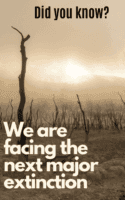A mass extinction is a time period in which a large percentage of all known species living at that time is completely wiped out. The last great mass extinction (the 5th) was 65 million years ago when 75% of all animal species were wiped out, including dinosaurs.
Scientists have found evidence which shows that the first five mass extinctions were caused by natural disasters: large volcanic eruptions; meteor hits, rising and falling sea levels and climate change. The fifth one, that wiped out the dinosaurs, was caused when a meteor struck the earth from space. The clouds of dust formed when it hit the earth caused what is called an ‘impact winter’. The sun was blocked which changed the temperature to freezing causing a Great Ice Age.
Many scientists believe we are in the middle of the 6th mass extinction because of the increased rate in which species are becoming critically endangered and extinct – up to 10 000 times faster than would occur naturally through adaptation and evolution.
The difference this time is that it will be the first mass extinction solely caused by humans. Already humans have wiped certain species off the face of the earth, and we can only read about these extinct animals in books. One of these is the flightless dodo.
In 1681- 362 years ago- the last Dodo bird was shot for sport on the island of Mauritius. There were no birds to breed from and the species became extinct. The dodo bird has become a symbol of Mauritius and you can buy all kinds of dodo merchandise, from clocks, to toys, to dishcloths, but you will never see a live one ever again.
Imagine telling your children or grandchildren about an animal called a rhino, that like the dodo bird, was wiped out by humans and can only be read about in books, or seen in a display at a museum. It is entirely possible with the rate animal species are becoming critically endangered and extinct.
In the last 500 years, human activity has forced over 800 species into extinction and there are many animals species on the critically endangered list. Rhinos are on the list of the ten most endangered species in the world, along with certain species of leopards, gorillas, turtles, buck, porpoises, elephant and orangutans. The IUCN (International Union for Conservation of Nature) predicts that 99.9% of critically endangered species and 67% of endangered species will be lost within the next 100 years.
The main human causes of species becoming endangered and extinct are deforestation, global warming, pollution and poaching. Recently large sections of the Amazon rain forest were burned down to clear the land for farming, and with it countless animals were destroyed along with their habitat. Burning fossil fuels for electricity is a major contributor to global warming, and the rise in sea temperatures is causing the ice shelves in the Arctic to melt. These are the home to polar bears which are becoming stranded on tiny islands of ice and starving as their home literally melts.
In South Africa we are all aware of how poaching for their horns is wiping out rhino populations and there is a desperate fight to keep these incredible creatures alive.
We depend on animals; our survival is linked to them. The food chain, from the tiniest microorganisms to the largest creatures on earth keeps us humans alive. If this chain is broken through a species becoming extinct it affects the entire system. There are also some species, such as bees, that we literally depend on for our food supply – without bees, our fruits and crops would not be pollinated.
We need to spread awareness and do what we can to protect our wildlife to ensure that our children and grandchildren still have a healthy earth to live on.
Some facts:
• At the rate at which insects are being destroyed the Earth may not have any insects at all by 2119. As described above, insects like bees are crucial as pollinators to keep crops alive. Bugs are food sources for many birds, fish and mammals many of which humans rely on for food.
• More than 26,500 of the world’s species are threatened with extinction, and that number is expected to keep going up.
• Currently, 40% of the planet’s amphibians, 25% of its mammals, and 33% of its coral reefs are threatened.
• Coral reefs and the animals they support are dying. Up to 50% of coral reefs have already died over the past 30 years alone.
• The loss of even one species could also cause an ‘extinction domino effect’ to ripple through an ecosystem, causing the entire biological community to collapse.
• 75% of all animal species could be extinct within a few human lifetimes.
• The total number of extinct species has reached 785 and a further 65 are only found in captivity or in cultivation.
Tell us: What do you think you can do to help prevent the extinction of animal species?


